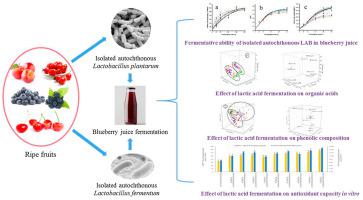Chemosphere ( IF 8.1 ) Pub Date : 2021-03-04 , DOI: 10.1016/j.chemosphere.2021.130090 Sujin Li , Yang Tao , Dandan Li , Guangzhong Wen , Jianzhong Zhou , Sivakumar Manickam , Yongbin Han , Wai Siong Chai

|
In this study, 4 Lactobacillus plantarum strains and 5 Lactobacillus fermentum strains adapting well to the unfavorable fruit system were isolated under different fruit environments. The fermentation ability of these autochthonous lactic acid bacteria (LAB) strains in blueberry juice, and the influence of microbial metabolism on juice composition were explored. After 48 h of fermentation, the viable cell counts exceeded 10.0 log CFU/mL, malic acid content decreased from 511.47 ± 10.50 mg/L to below 146.38 ± 3.79 mg/L, and lactic acid content increased from 0 mg/L to above 2184.90 ± 335.80 mg/L. Moreover, the metabolism of these strains exerted a profound influence on the phenolic composition of juice. Total phenolic content in blueberry juice increased by 6.1–81.2% under lactic acid fermentation, and the antioxidant capacity in vitro enhanced by at least 34.0%. Anthocyanin content showed a declining trend, while the profile of non-anthocyaninic phenolics exhibited complex changes. The increments of rutin, myricetin and gallic acid contents through 48 h lactic acid fermentation exceeded 136%, 71% and 38%, respectively. Instead, the contents of p-hydroxybenzoic acid and caffeic acid decreased with fermentation. Overall, Lactobacillus plantarum LSJ-TY-HYB-T9 and LSJ-TY-HYB-T7, and Lactobacillus fermentum LSJ-TY-HYB-C22 and LSJ-TY-HYB-L16 could be the suitable strains to produce fermented fruit juices, including blueberry in practical applications.
中文翻译:

使用从水果环境中分离的本地乳酸菌发酵蓝莓汁:发酵特性和酚类谱的演变
在这项研究中,有4株植物乳杆菌和5株发酵乳杆菌在不同的水果环境下,分离出了适应不良水果系统的菌株。探讨了这些乳酸菌在蓝莓汁中的发酵能力,以及微生物代谢对果汁成分的影响。发酵48小时后,活细胞计数超过10.0 log CFU / mL,苹果酸含量从511.47±10.50 mg / L降低到146.38±3.79 mg / L以下,乳酸含量从0 mg / L增加到2184.90以上±335.80毫克/升 此外,这些菌株的代谢对果汁的酚类成分产生了深远的影响。在乳酸发酵下,蓝莓汁中的总酚含量增加了6.1–81.2%,并且在体外具有抗氧化能力提升至少34.0%。花色素苷含量呈下降趋势,而非花色素酚类化合物的分布呈现复杂变化。乳酸发酵48小时后,芦丁,杨梅素和没食子酸的增量分别超过了136%,71%和38%。相反,对羟基苯甲酸和咖啡酸的含量随着发酵而降低。总体而言,植物乳杆菌LSJ-TY-HYB-T9和LSJ-TY-HYB-T7以及发酵乳杆菌LSJ-TY-HYB-C22和LSJ-TY-HYB-L16可能是生产发酵果汁的合适菌株,包括蓝莓在实际应用中。











































 京公网安备 11010802027423号
京公网安备 11010802027423号